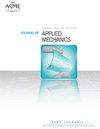化学机械耦合固溶体的抗断裂性能
IF 2.8
4区 工程技术
Q2 MECHANICS
引用次数: 0
摘要
锂离子电池和燃料电池电极等固溶体的断裂是由固态扩散和裂纹扩展之间复杂的相互作用介导的。在这项工作中,我们建立了一个成分依赖的内聚区模型,并将其与化学-力学耦合本构模型相结合,以研究固溶体的断裂机制。该计算框架用于研究化学-机械耦合固溶体在宽裂纹扩展速度范围内的有效断裂特性以及固有断裂能的成分依赖性。结果表明,裂纹速度是材料的有效抗断裂能力的重要特征,它由材料的扩散率与断裂能之比决定。我们还应用该模型研究了两相锂化硅(Si)和锗(Ge)纳米结构作为下一代锂离子电池候选高容量阳极的断裂行为,结果表明,Ge纳米结构比Si纳米结构更耐断裂。本文提出的计算研究为化学-机械活性材料系统的合理设计、操作和机械测试提供了重要的见解,以用于能量存储和转换。本文章由计算机程序翻译,如有差异,请以英文原文为准。
Fracture Resistance of Chemo-mechanically Coupled Solid Solutions
Fracture in solid solutions, such as electrodes for lithium-ion batteries and fuel cells, is mediated by intricate interactions between solid-state diffusion and crack propagation. In this work, we developed a composition-dependent cohesive zone model and integrated it with a chemo-mechanical coupling constitutive model to study the fracture mechanisms of solid solutions. The computational framework was used to investigate the effective fracture properties of chemo-mechanically coupled solid solutions over a wide range of crack growth velocities and compositional dependence of intrinsic fracture energy. The results revealed an important characteristic crack velocity, which is set by the ratio of the diffusivity to the intrinsic fracture energy and dictates the effective fracture resistance of the material. We also applied the model to study the fracture behavior of two-phase lithiated silicon (Si) and germanium (Ge) nanostructures as candidate high-capacity anodes for next-generation lithium-ion batteries, and showed that Ge nanostructures are more fracture resistant than their Si counterparts. The computational study presented here provides important insights for the rational design, operation, and mechanical testing of chemo-mechanically active material systems for their use in energy storage and conversion.
求助全文
通过发布文献求助,成功后即可免费获取论文全文。
去求助
来源期刊
CiteScore
4.80
自引率
3.80%
发文量
95
审稿时长
5.8 months
期刊介绍:
All areas of theoretical and applied mechanics including, but not limited to: Aerodynamics; Aeroelasticity; Biomechanics; Boundary layers; Composite materials; Computational mechanics; Constitutive modeling of materials; Dynamics; Elasticity; Experimental mechanics; Flow and fracture; Heat transport in fluid flows; Hydraulics; Impact; Internal flow; Mechanical properties of materials; Mechanics of shocks; Micromechanics; Nanomechanics; Plasticity; Stress analysis; Structures; Thermodynamics of materials and in flowing fluids; Thermo-mechanics; Turbulence; Vibration; Wave propagation

 求助内容:
求助内容: 应助结果提醒方式:
应助结果提醒方式:


